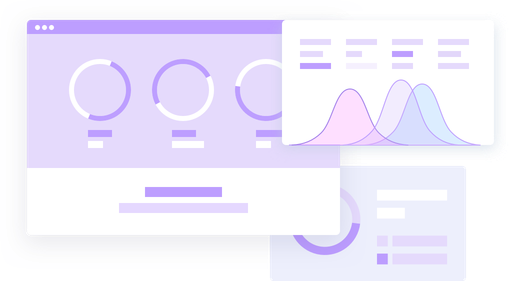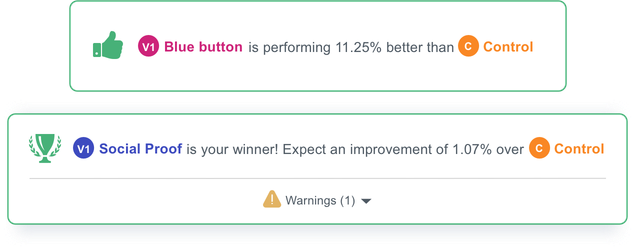A/B Test Statistical Significance Calculator
Want to run an online A/B test? Calculate its significance with our Bayesian-powered calculator built for experimentation, CRO, and UX Optimization.
P-Value
0Significant?
YesThe P-Value is x.xx Hence, your results are statistically significant!
Awesome, you understand what p-value stands for! Unfortunately most people are unable to correctly interpret p-values. Hence we built VWO SmartStats, a Bayesian statistical engine that dispenses with the need of a p-value altogether.
Unfortunately, this isn't what the p-value actually means. Don't worry, most people are unable to correctly interpret p-values. Hence we built VWO SmartStats, a Bayesian statistical engine that dispenses with the need of a p-value altogether.
P-Value
(Range from 0-1)0.334
Significance
No
What is statistical significance?
Statistical significance quantifies whether a result obtained is likely due to chance or some factor of interest. You can utilize a significance calculator to confidently evaluate and interpret your results. The data-driven approach empowers you to make informed decisions for optimization and ultimately achieve your desired outcomes.
Different approaches to calculate statistical significance
The two commonly used approaches are Frequentist and Bayesian, which power different test statistics calculators. Here is a brief information on each.
Frequentist
Frequentist statistics involves examining the frequency of events. It looks at how often something happens in a given situation.
Bayesian
Bayesian statistics is all about changing your opinion. It starts with an initial belief called the prior, which comes from domain expertise. Then, you gather evidence to support or challenge that belief. After examining the evidence, your opinion should be updated based on the new information you’ve acquired.
How do we calculate statistical significance?
Here is how you can calculate statistical significance using the Frequentist and Bayesian approaches.
Frequentist approach
The Frequentist approach to statistical significance is based on the p-value. To determine the p-value using the Frequentist approach, you will need the following key pieces of information:
- The mean difference between the two hypotheses
- The standard deviation of the difference between the two hypotheses
- The sample size of each hypothesis
Once you have gathered this necessary data, you can easily compute the p-value using a significance testing tool or significance level calculator. If the p-value you get is 0.05, the probability of the variation is 5%.

Bayesian Approach
In this, you do statistical significance calculation through posterior probability. The posterior probability considers the available data and represents the probability of hypothesis A or B being true. The approach takes into account both prior beliefs and the evidence observed in the data.
To calculate the posterior probability, Bayes' theorem is employed. Bayes' theorem is a mathematical formula that combines the prior probability of a hypothesis with the likelihood of the data to derive the updated or posterior probability.
A posterior probability of greater than 95% is considered to be strong evidence in favor of the hypothesis.
Know more about the mathematical formula for Frequentist and Bayesian approach in a whitepaper that we wrote on Bayesian A/B testing at VWO.

Why do we use Bayesian statistics?
Intuitive Test Reports
At VWO, we recognize that non-statistical users often misinterpret the frequentist p-value as a Bayesian posterior probability, which leads to incorrect conclusions about the superiority of one variation over another. To address this issue, we developed the industry's first Bayesian statistical engine.
Our Bayesian statistical engine provides users with easily understandable results, eliminating the risk of making mistakes while conducting A/B tests on revenue or other crucial key performance indicators (KPIs). By adopting a more intuitive approach, we ensure that our users obtain accurate insights from our A/B test statistical significance calculator.
With our solution, you can have confidence in the statistical significance of your results, making informed decisions to optimize your testing, revenue generation, and overall user experience. Say goodbye to misinterpretations and embrace the power of the Bayesian A/B test calculator for reliable and actionable A/B testing outcomes.

No Sample Sizing Required
VWO SmartStats relies on Bayesian inference which unlike a frequentist approach doesn’t need a minimum sample size. This allows you to run A/B tests on parts of your website or apps that might not get a lot of traffic to improve them. However, getting more traffic on your tests allows VWO to determine your conversion rates with more certainty allowing you to be more confident about your test results.

Actionable Results, Faster
VWO SmartStats was engineered keeping one key metric in mind: Speed. We have traded-off some accuracy for speed, not a lot, just a tiny bit, enough to get quicker results without impacting your bottom line. This frees up your time enabling you to test more. Also, on the off chance that you would want to be absolutely and completely sure, we calculate the maximum potential loss you'd be taking, and you can decide if the loss value matches your risk appetite.

Frequently Asked Questions
The null hypothesis states that there is no difference between the control and the variation. This essentially means that the conversion rate of the variation will be similar to the conversion rate of the control.
The p-value is defined as the probability of getting results at least as extreme as the ones you observed, given that the null hypothesis is correct, where the null hypothesis in A/B testing is that the variant and the control are the same.
Statistical significance quantifies whether a result obtained is likely due to a chance or some to some factor of interest. When a finding is significant, it essentially means you can feel confident that a difference is real, not that you just got lucky (or unlucky) in choosing the sample.
Statistical power is the probability of finding an effect when the effect is real. So a statistical power of 80% means that out of 100 tests where variations are different, 20 tests will conclude that variations are the same and no effect exists.










